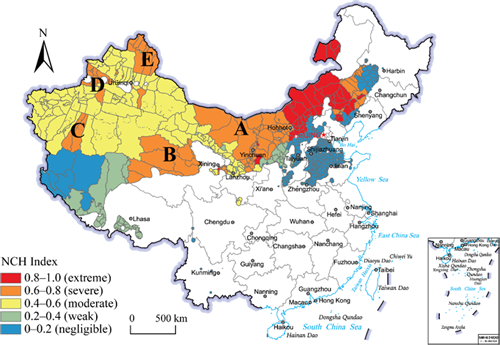Researchers Estimate Distribution of Hotspots for Desertification Research in China Using the Normalized Comprehensive Hotspots Index
According to the latest Bulletin on Desertification in China, desertification land in China accounts for 27.20% of the country’s total land area. Therefore, determining the status of desertification research in China is a top priority.
Associate Professor HU Yunfeng’s team at the Institute of Geographic Sciences and Natural Resources Research of the Chinese Academy of Sciences used the Normalized Comprehensive Hotspots Index (NCH) to determine the spatial distribution of hotspots for desertification research based on the number of Chinese articles.
The research results showed that the number of desertification studies in China has shown a general downward trend. This work was published in the Journal of Resources and Ecology.
In contrast to traditional bibliometric methods that rely on human knowledge and expert experience to summarize literature knowledge, this research worked on improving accuracy, efficiency and credibility of efforts to assemble literature knowledge.
The core of this research method is the supervision mechanism, which is based on Java language to achieve an intelligent extraction of information from documents. Researchers input keywords, and the machine searched, relying mainly on word segmentation and toponym matching to produce results.
Unlike standardized comprehensive hot region indexes proposed before, Liang Yuting and her colleagues added calculation of the NCH index and analyzed the dynamic changes of research hotspots by calculating the slope of desertification research hotspots during 1980-2018 in China.
 |
| Fig. 1 Spatial distribution of NCH Index of desertification research since the 1980s (Image by HU Yunfeng’s team) |
It became evident that use of the NCH index ensured that the results produced by this research were highly consistent with our traditional understanding of the spatial distribution pattern. The study found that the hotspots for China’s desertification research from the 1980s through 2018 were largely distributed in five regions: areas A, B, C, D and E (Fig. 1).
Among these regions, the Agro-Pastoral Ecotone in the middle and eastern parts of Inner Mongolia contained the most prominent hotspots for the study of desertification. Therefore, the method used to identify hotspots in this study can be applied in much the same way to other research fields.
Reference:
LIANG Yuting, HU Yunfeng, HAN Yueqi. 2019. Spatial Distribution and Dynamic Changes in Research Hotspots for Desertification in China based on Big Data from CNKI. Journal of Resources and Ecology, 10(6): 692–703.
Download attachments: